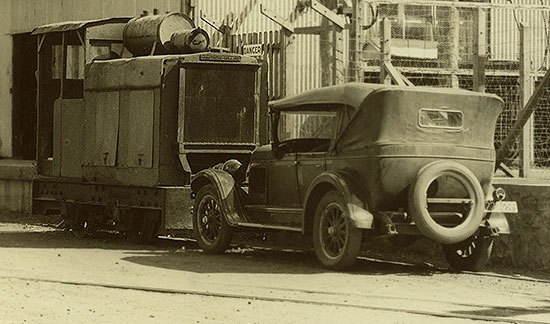Australia’s First Diesel Locomotive
If I were to ask you to name the maker of Australia’s first locally built diesel locomotive I’m sure that most of you would have an answer but it’s unlikely that it would be the right answer.
Of course some people would nominate Clyde’s GM1 Class from 1951 while others might suggest the D1 Class shunters built for Australian Iron and Steel in 1950 but they would not be correct.
If you were from South Australia you might suggest that the two 350 Class shunters built by the South Australian Railways workshops in 1949 were the first but that would not be correct either.
If you were a Queenslander you would probably know that the Ipswich Railway Workshops built the first DL Class diesel locomotive in 1939 but that wasn’t the first Australian build diesel locomotive either.
This little 12 ton, 3 foot gauge, monster was one of three locomotives built by Armstrong Holland in 1930 and fitted with an imported engine1. These locomotives were built for use in the construction of Wyangala Dam in NSW that was being built by the Metropolitan Water, Sewerage and Drainage Board2

One of the three diesel locomotives built in 1930 by Armstrong Holland seen here during the construction of the Somerset Dam in Queensland.
In 1935 the locomotives, thought to be named Dulce, Jack and Archie, were in the possession of the Stanley River Works Board and were being used in the construction of the Somerset Dam. In 1949 Dulce was sold to a Mr Moore, sawmiller of Mt Hallon where it was subsequently scrapped without being used3.
Neither of the other two locomotives survived.
Armstrong Holland Pty Ltd
Not a whole lot is known about the firm of Armstrong Holland Pty Limited.
The company’s head office was located at 4 Bridge Street Sydney and Armstrong-Holland (Melb) Pty. Ltd. was located at 72 Market Street South Melbourne with agents in all the other major capitals.
On a number of their brochures the company name was displayed without a hyphen while on other brochures a hyphen is used. The manufacturer’s name on the locomotive does have a hyphen.
On one of its brochures the company is described as “Australian Distributors for International Industrial Power” while other brochures clearly state that it was a manufacturer of heavy equipment ranging from graders and scrapers through to concrete and ashphalt plants.
Armstrong Holland built other motive power besides these three 12 ton locos. Three smaller 0-4-0PM tractors were built for Wyangala Dam in 1930-31 and they went on to work on the construction of Burrinjuck Dam and there may be others that I am yet to come across.
A note on Flickr (of all places)4 suggests that the company commenced business in the early 1920’s and faded away around 1980.
References
1. https://www.railpage.com.au/f-p177359.htm#177359
2. Information supplied by John Armstrong via email on the LRRSA email group – thread no. 7966
3. Information supplied by Richard Horne via email on the LRRSA email group – thread no. 7966
4. https://www.flickr.com/photos/94854784@N06/sets/72157641452797184/
Photo supplied by the State Library of New South Wales